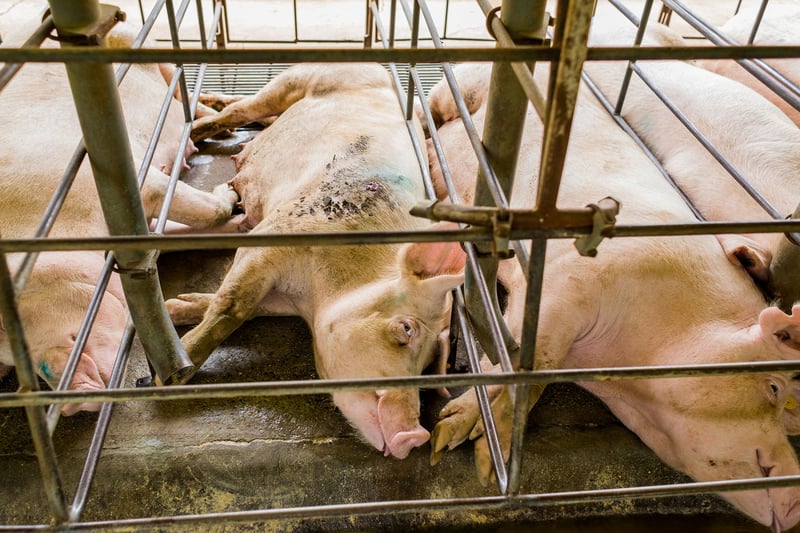
Routine overuse of antibiotic drugs across entire groups of healthy farmed animals props up low-welfare practices and drives the spread of antibiotic-resistant bacteria that cause life-threatening infections in people. New data reveal that despite industry promises to address the issue, sales of antibiotics to farmed animal producers are on the rise.
Since 2009, the US Food and Drug Administration has been required to publish annual data from manufacturers of antibiotic drugs on the volume of antibiotics sold or distributed for use in food-producing animals. These data have been the only information available to the public providing a glimpse into the total amount of antibiotics likely given to farmed animals in the US each year.
According to the new data for 2019, domestic sales of medically important antibiotics intended for farmed animals increased by 3% from 2018, up to 6.1 million kilograms (kg), or 13.4 million pounds. An additional 5.2 million kg (11.5 million pounds) of antibiotics not considered medically important were sold that year for use in domestic farmed animals.
Tetracyclines, which were the largest class of drugs sold by volume, increased by 4%. In 2019, tetracyclines accounted for 67% of all medically important antibiotics sold domestically, with the pig industry accounting for 50% of these sales. In 2019, World Animal Protection’s retail pork products’ testing found 21 of the 32 sample batches (66%) contained bacteria resistant to tetracyclines, and 56% of the Enterococcus bacteria and 64% of the E. coli isolated from batches were resistant to tetracyclines.
The pork industry was also the largest market for lincosamide antibiotics, accounting for 85% of sales. In World Animal Protection’s 2019 testing, 28 of the 32 sample batches (88%) contained bacteria resistant to lincosamides, with 96% of the Enterococcus bacteria and 100% of the Listeria isolated from the batches resistant to lincosamides. While lincosamides constitute a small percentage of the overall volume of antibiotics sold annually, their sales did increase by 8% from 2018 to 2019.
Medically important antibiotics continued to go largely to the pork, dairy, and beef industries, with 41% of drugs sold intended for use in cattle, 42% intended for use in pigs, 10% intended for use in turkeys, and 3% intended for use in chickens. Notably, this marks a shift from previous years, with pigs overtaking cattle as the top market for medically important drugs. In 2018, drugs for use in cattle accounted for 42% of total sales, and those for use in pigs 39%. From 2018 to 2019, sales of antibiotics intended for use in pigs increased by 9%.
Intensive farmed animal facilities—also called factory farms or CAFOs—rely on providing animals with continuous doses of antibiotics to maintain high densities and poor conditions. The intense stress, overcrowding, poor diets, and breeding for rapid growth make the animals susceptible to disease and infection, compromising their productivity. Regularly dosing animals with antibiotics is a low-cost way to keep highly-stressed, immune-compromised animals alive, and putting on extreme weight.
When continuously exposed to low doses of antibiotics, the bacteria on farms and in the animals that survive develop the ability to continue fighting not only the specific drug used, but similar drugs as well. Resistant bacteria, called “superbugs,” pass resistance on via reproduction or sharing resistance genes with other bacteria.
Polling by World Animal Protection in 2020 found that 84% of people in the US underestimate the percentage of all antibiotics that go to farmed animals and that 79% are concerned about the spread of superbugs from farmed animals. Further, 82% believe that antibiotics should only be used on farmed animals that are sick.
The FDA has taken specific steps to restrict producers from using medically important antibiotics solely to promote rapid weight gain. Since 2017, drugs have not been allowed to include growth promotion uses on their product labels or be marketed to producers for this purpose. However, the FDA continues to allow medically important drugs to be used routinely for “disease prevention”—mass administering drugs to entire groups of healthy animals to ensure their health is not compromised by the diseases and bacteria that can spread rapidly in low-welfare environments. Not only does this enable producers to cut costs associated with providing better housing and using higher welfare breeds, but this continuous reliance on antibiotics provides growth benefits at the same time.
Sales of medically important antibiotics for farmed animals peaked at 9.7 million kg (21.4 million pounds) in 2015, just ahead of the new rules prohibiting drug companies from marketing growth promotion uses going into effect. However, after only two years of declining volumes, sales have been going back up since 2017.
This is a clear indication that more must be done to push the farmed animal industry to achieve the reductions in use necessary to protect public health and animal welfare. You can act now! Help us by signing our petition to the FDA to strengthen antibiotic regulations and prohibit routine use across entire groups of animals.